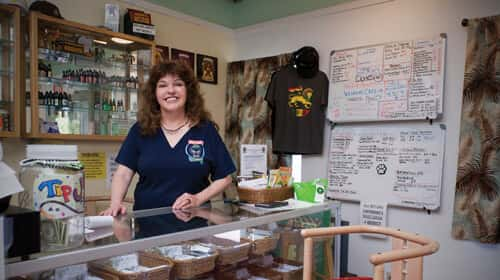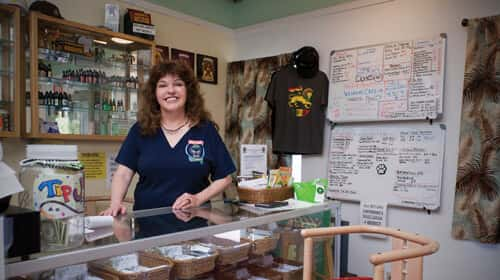
On a windy Saturday afternoon, the once-bustling Marin Alliance for Medical Marijuana is barren, the chairs against the wall sit empty. Two wipe boards show the dispensary’s limited offerings, a pair of glass cases display buds that seem lonely.
In its heyday, the dispensary boasted 45 strains of marijuana, now it’s down to eight. Tinctures? The shop has two varieties, off from the previous dozen on its shelves. By law the dispensary can only stock products from licensed companies, and the state/local licensing process makes time spent at the DMV seem to whiz by.
Since recreational cannabis became legal January 1, business at the clinic has fallen off a table. “Patients are going to Healdsburg and Cotati in droves,” says Lynnette Shaw, who founded the Alliance and runs the dispensary. She sounds wistful.
Perhaps the best way to describe the current North Bay cannabis scene is dazed and confused.
Marin has one place to buy cannabis, the Alliance. How is it in Napa County? Still waiting on its first place to buy pot.
On the other hand, Sonoma has at least 5,000 growers and there could be as many as 12,000 people working in the budding sector. But there is a smoldering controversy over where people can grow cannabis.
In the liberal North Bay—a bastion of wealth, education and sophistication—the take is decidedly mixed when it comes to weed. Marin approved Prop 64 with 70 percent of the vote, Sonoma citizens gave it 59 percent and denizens of Napa said yes to the tune of 56 percent, one percentage point shy of the state-wide approval rate of 57 percent.
A maze of local regulations
While there is clear support for cannabis locally, that doesn’t mean that decisions on how people can buy it will be easy. The local regulations are a byzantine maze that have attempted to balance the fear of the unknown, with a need for structure and a sense that the cannabis business is a beast waiting to happen. And this doesn’t even touch the state regulations.
 Soma Rosa Farms is a Sonoma-based growing company run by Ned Fussell. It was formerly the in-house grow component of CannaCraft and still supplies the company with organic cannabis. Fussell says multiple regulations are a challenge. “What the state might allow, the county might not, what the county might allow the city may not—and then you have the corresponding agencies and commissions that have to sign off. It’s a lot of cooks in the kitchen and no one is really certain on what the recipe is yet. It’s hard to work with,” says Fussell.
Soma Rosa Farms is a Sonoma-based growing company run by Ned Fussell. It was formerly the in-house grow component of CannaCraft and still supplies the company with organic cannabis. Fussell says multiple regulations are a challenge. “What the state might allow, the county might not, what the county might allow the city may not—and then you have the corresponding agencies and commissions that have to sign off. It’s a lot of cooks in the kitchen and no one is really certain on what the recipe is yet. It’s hard to work with,” says Fussell.
And just as Santa Rosa is different from San Rafael, the regulations in each city and town vary widely. So exactly what is allowed in each city in the North Bay?
In Sonoma County, Sebastopol and Santa Rosa allow growing indoors and out, recreational, medical, commercial growing, manufacturing, distribution and testing. Cotati, Cloverdale, Rohnert Park and the county are good with everything but outdoor growing. Petaluma, the city of Sonoma, Windsor and Healdsburg allow indoor growing. The county only allows medical cannabis and delivery is not allowed in unincorporated Sonoma.
Marin county itself currently doesn’t allow any cannabis activity. Fairfax has indoor and outdoor growing along with medical sales. Former Fairfax mayor Lew Tremaine filed a local ballot initiative to allow rec sales and licensing of local organic growers in Fairfax. The Town Council can either adopt an ordinance or ask the voters, who passed Prop 64 with 77.6 percent of the vote.
San Rafael is wrestling with a taxing structure for cannabis as well as commercial zoning for cannabis business. The city is proposing to allow a licensing program for testing, sale of medical cannabis-infused products and delivery businesses. But only four licenses would be issued for delivery and testing, while eight permits covering sale of cannabis-infused products would be allowed. No commercial cultivation, medical or adult use dispensaries will be allowed under the proposal which goes to voters June 5. Corte Madera allows indoor and outdoor growing and Ross, Tiburon, Sausalito, Mill Valley, Belvedere and Larkspur all allow indoor growing.
In Napa County, American Canyon, St. Helena, Yountville allow indoor growing, Calistoga allows indoor and outdoor grows.
Growing pains
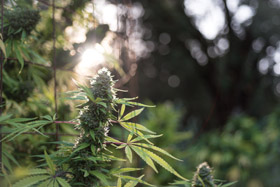 While Sonoma seems like a place that has done a good job of making the county a more welcoming place for cannabis business, County Agriculture Commissioner Tony Linegar pointed out in March at a public meeting that the valley known for bending over backwards to accommodate the wine industry, has fallen short. “If the overall goal of the program was to favor a corporate, big dollar, new money industry then we have succeeded,” Linegar said. “If the goal was to create a workable pathway for existing operators, then I think we have failed.”
While Sonoma seems like a place that has done a good job of making the county a more welcoming place for cannabis business, County Agriculture Commissioner Tony Linegar pointed out in March at a public meeting that the valley known for bending over backwards to accommodate the wine industry, has fallen short. “If the overall goal of the program was to favor a corporate, big dollar, new money industry then we have succeeded,” Linegar said. “If the goal was to create a workable pathway for existing operators, then I think we have failed.”
His remarks were greeted with cheers.
Linegar estimates there are 5,000 to 7,000 growers in the county and just a trio have received permits.
The county has also struggled with the fact that some residents who live in rural areas are reluctant to have cannabis cultivation operations as neighbors. Those opposed to growing say they’re uncomfortable with possible public safety issues as well as having grows take place in family areas. Cannabis advocates have complained that existing policies are already difficult as well as expensive and changing them would make it harder for those in the trade to follow the regulations and possibly drive some out of a regulated market into a black market.
Soma Rosa Farms is in the cultivation business. Fussell heads up Soma Rosa and reports that since recreational pot was legalized, it’s been a mixed bag for the company of 50 full-time employees. “It’s opened up communication between cannabis and other industries,” he says. “Cannabis cultivators were accustomed to operating in the shadows for so long. So with the state changes, it’s allowed us to be fully transparent, make connections to outside partners, and support our local communities.”
But the company still has some of the old challenges. “Being fully transparent and known publicly has unfortunately made it more difficult for banking since majority of them do not do business with cannabis companies,” says Fussell.
Since the feds have made it clear that federally regulated banks can’t do business with cannabis companies, folks like Soma Rosa have had to resort to creative ways to safeguard revenues as well as gain access to banking. Fussell points out that not having access to normal banking makes day to day operations difficult such as paying vendors. “Not only does it make cannabis business vulnerable, but it also forces us back into this grey area that we have tried so hard to step out from,” he adds. “We are trying to be transparent and follow all the rules. However, people quickly assume the worst about the cannabis industry.”
Colorado booked $247 million in taxes off legal marijuana sales in 2017 and they spent a lot of that cash on schools, according to state records. Cannabis sales in Nevada for the first six months it was legal were higher than Colorado.
So when California made it legal for adults to use cannabis recreationally, it was going to not only make those adults feel pretty good, it was going to generate millions in tax revenues for the state that could go for education, social and medical programs as well as cannabis research. Cue the Kumbaya tape. But state records show that tax revenues on the bud are lower than anticipated, totaling just $34 million in the first quarter. The confusion and difficulty in permitting clearly reaches beyond the local jurisdictions. And that difficulty is costing Sacramento cash because when it comes to cannabis, California is truly the Golden State.
The digits
Let’s run the numbers. Cowen and Company, a New York-based investment bank, says the U.S. cannabis sector will be worth $75 billion a year by 2030.
MedMen, a chain of retail dispensaries based in Los Angeles, is valued at $1 billion making it the first cannabis unicorn.
Green Organic Dutchman, a Canadian cannabis grower went public in a May IPO, raising $115 million.
Both the New York Stock Exchange and Nasdaq have cannabis companies listed.
According to polling by Pew Research, 61 percent of people in the U.S. believe that marijuana use should be legal everywhere. That number hits 70 percent if you factor in millennials.
A total of 29 states have made medical cannabis legal, nine states allow recreational use.
California, the 5th largest economy in the world, is also the largest cannabis market on Earth. The Golden State made medical cannabis legal in 1996, more than two decades ago. And of course, recreational use of marijuana by adults became legal January 1 after Prop. 64 passed with 57 percent of the vote in 2016.
So with all of that love going on for cannabis, the North Bay should be awash in the green stuff. And it is, there’s no shortage of product in the black market. But the new legal market is a different animal.
From shadows to sunshine
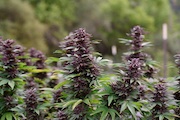 Getting a handle on local cannabis business isn’t easy. Folks are busy building their companies and they don’t have lots of free time to talk about the market and their place in it. And the environment itself is strange in that the public seems to want the opportunity to use marijuana, but elected officials in Napa and Marin are struggling with the regulation piece.
Getting a handle on local cannabis business isn’t easy. Folks are busy building their companies and they don’t have lots of free time to talk about the market and their place in it. And the environment itself is strange in that the public seems to want the opportunity to use marijuana, but elected officials in Napa and Marin are struggling with the regulation piece.
There is also the federal overhang. Like it or not, marijuana is still a schedule 1 drug, according to the Drug Enforcement Agency, which means that in the eyes of the feds, there is a high abuse potential, no established medical use and pot is on the same platform as heroin and cocaine.
Moreover, current federal banking laws put banks at risk if they do business with cannabis related companies, keeping dollars out of the banking system and giving cannabis businesses considerable security risks.
Then there is the evolving culture. For years, it was pot or weed—cannabis was a word guys in white coats used when they were getting high. It was grown in the Emerald Triangle of Mendocino, Trinity and Humboldt Counties. Growers and sellers played a dangerous game of hide and seek with local and federal authorities while the local economies thrived on the open secret that the cash crop kept other businesses open. Some of that product made its way south on Highway 101 passing through both Sonoma and Marin on its way to other destinations.
During that time, cannabis was in the shadows. Even when medical became legal, dispensaries were not often found smack dab in the middle of downtown, but rather they were relegated to strip malls with the curtains drawn and low-key signs.
If Marin and Napa are much of a measure, that culture is hanging on.
Finally, there is a culture clash within the cannabis community. On one side there are pioneers like Shaw of Marin Alliance for Medical Marijuana who literally had to fight the feds and was closed down in 2011. She is considered the godmother of dispensaries, the matriarch of marijuana. She and other like her blazed a trail and took considerable risk to make cannabis available for those seeking medical pot.
There are folks like Brent Buhrman, owner of Aura-Farms in Southern California. I met Brent walking through a casino in Las Vegas during a cannabis conference in 2014. With a stark white mowhawk and matching patent leather loafers, Buhrman told me how he had been in the marijuana business for almost three decades, but the evolving environment was his chance to go legit and stop listening for funny clicks on his phone. “There are people in this room that don’t have any idea what to do with marijuana. But they know there is an opportunity here, and they have money. I’m the kind of guy who can help them build a business.”
The people that he was talking about were like the founders of MedMen, which has had its stores compared favorably to Apple locations, including its outlet on tony 5th Avenue in Manhattan. The company was started by a pair of marketers who didn’t know the first thing about cannabis, but they looked at the margins of some dispensaries and saw a business opportunity. They are now backed by private equity and have gone public in Canada.
“We call them green rushers,” said Shaw.
But there is an uneasy alliance between those who founded the cannabis industry and who those have come late to the party, but with plenty of cash in their pockets. And that too shapes the cannabis sector.
According to the Californian, a publication that tracks the cannabis industry statewide, only one in seven cities allow recreational sale of marijuana across the 482 cities and towns in California. Less than one in three allow any kind of cannabis business and less than one in five allow medical cannabis.
So, the local officials trying to get their arms around legal cannabis have companies up and down the state. Inge Lundegaard is cannabis program manager for Marin County. There is a learning curve going on in the cannabis industry that stretches from residents to regulators to those in the business. “A very heavy learning curve,” she says.
Lundegaard says that for regulators the strain isn’t just learning about the industry or understanding new regulations, it is trying to balance the concerns and needs of community members with those in the business and helping them make sense of the new regulations.
Shaw says that all of the regulation that has come in with Prop 64 is strangling the legal businesses and acting like a turbo-charger for the black market. “We used to sell an 1/8th (of an ounce) for $30, $35. But with the taxes, we now have to sell it at $50. Meanwhile, you can get it on the street for $40.”
Her dispensary is not currently allowed to sell recreational cannabis. But she and others are working to change the local regulations. “The fact is that people in Fairfax support recreational cannabis, 77.6 percent voted for it. By not having someplace to buy it locally, they are not listening to the people.”
Shaw is in it for the long haul. She opened the dispensary a bit before it became legal in California in 1996 and attracted the interest of the feds. The federal government closed the Fairfax dispensary down in 2011 and the case meandering through the courts. In 2017, the federal prosecutors who brought the case and subsequent appeals were shown the door when the Trump administration cleaned house of Obama officials. The dispensary reopened last year, but Shaw confesses that a lot of damage has been done. “Some people don’t even know we are open again.”
In some ways, it’s ironic. California has long been known as a place that not only grew some of the world’s best weed, but a location where its use was pretty much accepted. The voters have spoken twice and approved both medical and recreational use. And despite all of the anti-California rhetoric coming out of the White House as well as the marijuana-is-evil chat from Attorney General and part-time lawn gnome Jeff Sessions, the feds are unlikely to make any big moves in the Golden State.
And yet for North Bay consumers wanting to buy cannabis after they voted to make it legal, the best advice is hurry up and wait.
Author
-
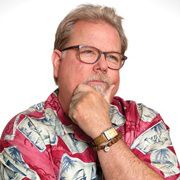
Bill Meagher is a contributing editor at NorthBay biz magazine. He is also a senior editor for The Deal, a Manhattan-based digital financial news outlet where he covers alternative investment, micro and smallcap equity finance, and the intersection of cannabis and institutional investment. He also does investigative reporting. He can be reached with news tips and legal threats at bmeagher@northbaybiz.com.
View all posts


